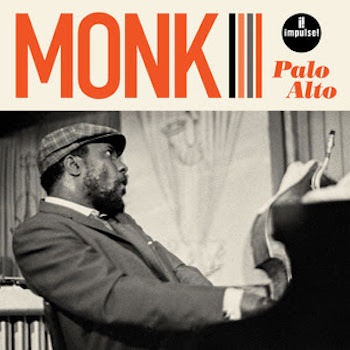Jazz Album Review: “Monk: Palo Alto” — An Unlikely but Welcome Discovery
By Michael Ullman
This 1969 concert by the Thelonious Monk Quartet was produced by a high school student and recorded by his school’s janitor. It presents this particular group at its optimistic best.
Monk: Palo Alto (Impulse)

Could anything be less likely? This 1969 concert by the Thelonious Monk Quartet was produced by a high school student and recorded by his school’s janitor. Its publicity posters were printed up by the Palo Alto High School Graphic Arts Department. The janitor, we are told, received permission (but from whom?) to tape the concert as a reward for his having tuned the piano. Before the concert, only a few tickets were sold, but then a crowd gathered outside the school. People wanted to see Monk and the two opening acts, but didn’t necessarily believe that the great pianist/composer would show up. After all, he was appearing that night in a club in San Francisco.
Remarkably, he did appear, and in a good mood, with his oft-recorded quartet of tenor saxophonist Charlie Rouse, bassist Larry Gales, and drummer Ben Riley. Equally remarkably, the recorded sound, in stereo, is excellent. Its main flaw is the close recording of the drum set, but even that is interesting. That janitor, whose very existence I somehow doubt, had skills. In Palo Alto, Monk played his standard set: four of his most famous originals, the ballad “Don’t Blame Me” and, as an encore, a mini-version on solo piano of “I Love You Sweetheart of My Dreams,” an obscure song that was introduced into the repertoire by Rudy Vallee and promptly forgotten by everyone but Monk, who used it repeatedly as a short finishing touch to his concerts. (There are a pair of mini versions on his Paris 1969 concert recordings.) At the end, Monk tells the crowd he’d like to play more for them but: “We have to hurry back and get to work, you dig?”
The implication is that this concert in a high school auditorium wasn’t work. It doesn’t sound like it. For whatever reason — perhaps knowing that they had less than an hour to perform? — the band and Monk himself are particularly energized, even excited, to the point that even this familiar repertoire sparkles. The set begins after a smattering of applause, a few whistles, and some seemingly random notes from Monk, who then plays a few solid chords to introduce his “Ruby, My Dear,” which the quartet plays in a jaunty, upbeat style. Rouse clips his phrases and Monk springs from note to note with the high spirits of a giggly child. It’s an auspicious beginning: here’s a piece the band had played seemingly to death, but here it comes to sprightly new life. The recording balance allows us to hear clearly the subtle rhythmic interchanges between Monk and the drums. Monk ends the tune with one of his downward runs, this time played flawlessly. Then he begins “Well, You Needn’t” solo. Behind Rouse, Monk plays thumping chords, some so deep in the bass they sound like a drum, and fragments of his melody. When Rouse reaches the bridge, Monk puckishly plays a chord on the first beat of each measure, sounding like a modernist version of Count Basie. “Don’t Blame Me” is a solo vehicle for Monk. Again the tempo is brisker than on most ballads: a good sign that Monk is thrilled. He becomes increasingly emphatic each succeeding chorus, until about five minutes into the performance he decides to take the tune out of tempo. Monk then repeats his version of the melody, decorated with almost comical trills. The crowd is appropriately appreciative.
Then there’s “Blue Monk,” which features a long, effective solo by Rouse, during which Monk lays out. Monk’s solo contains phrases we have heard before (and will afterwards). But there’s plenty that’s new here as well. Bassist Gales gets a solo in this 14-minute version: he and Riley deserve more credit than they are most likely going to get for this session. In mid-solo, Gales plucks the strings of his bass way up high: he suddenly sounds like he’s playing a toy instrument. Monk wasn’t the only eccentric on stage. An uptempo version of “Epistrophy” follows. It provides a wild, lively ending to a concert that presents this particular quartet at its optimistic best. Monk sounds sincere when he says he’d like to play more for this audience. I wonder how he sounded in San Francisco later that night.
Michael Ullman studied classical clarinet and was educated at Harvard, the University of Chicago, and the U. of Michigan, from which he received a PhD in English. The author or co-author of two books on jazz, he has written on jazz and classical music for the Atlantic Monthly, New Republic, High Fidelity, Stereophile, Boston Phoenix, Boston Globe, and other venues. His articles on Dickens, Joyce, Kipling, and others have appeared in academic journals. For over 20 years, he has written a bi-monthly jazz column for Fanfare Magazine, for which he also reviews classical music. At Tufts University, he teaches mostly modernist writers in the English Department and jazz and blues history in the Music Department. He plays piano badly.
Tagged: Ben Riley, Charlie Rouse, Impulse, Larry Gales, Monk: Palo Alto, Thelonious Monk
